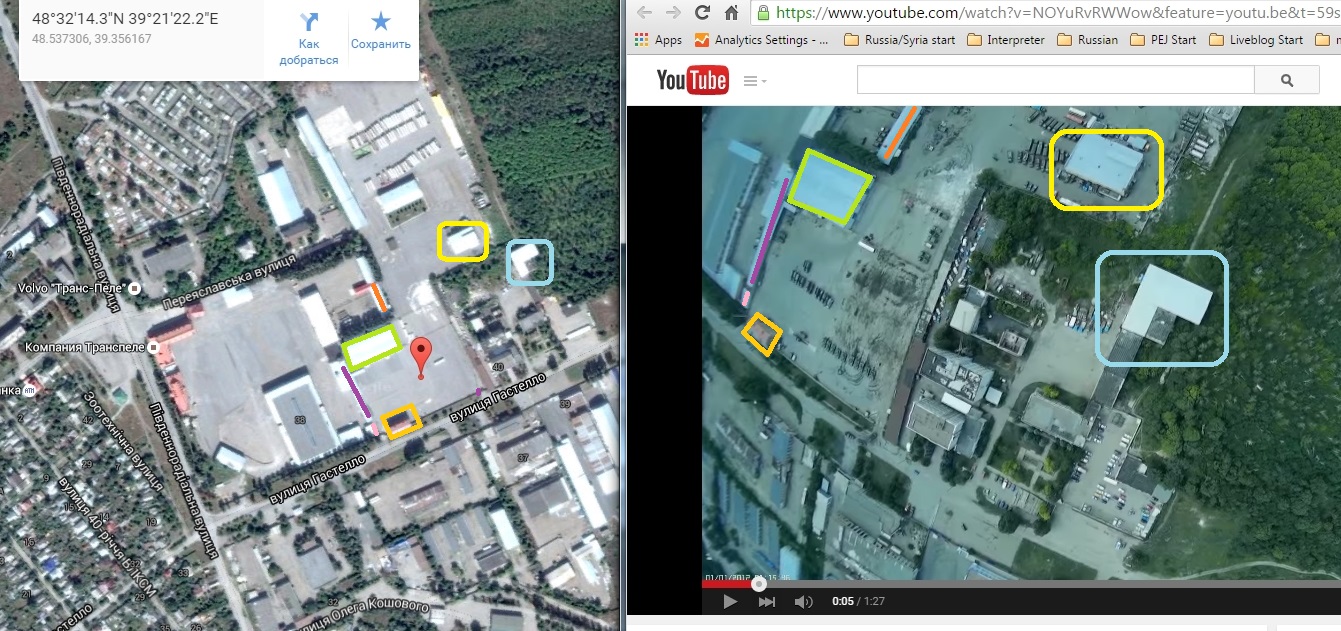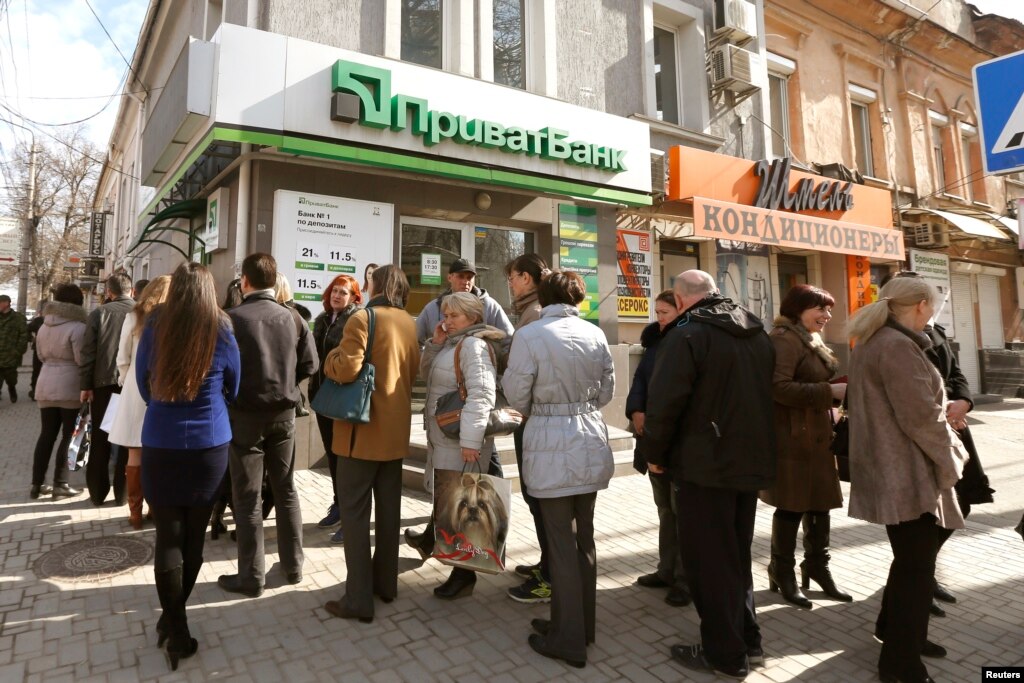Yesterday’s live coverage of the Ukraine conflict can be found here. An archive of our liveblogs can be found here. For an overview and analysis of this developing story see our latest podcast.
Please help The Interpreter to continue providing this valuable information service by making a donation towards our costs.
For links to individual updates click on the timestamps.
For the latest summary of evidence surrounding the shooting down of flight MH17 see our separate article: Evidence Review: Who Shot Down MH17?
We have not found any other record of this video having been uploaded before July 8. It appears that the video was originally posted by Ukrainian blogger Yury Kasyanov who regularly posts videos of this nature.
The video appears to show a line of about 10 armored vehicles and a larger group of camouflaged trucks parked in what appears to be a parking lot. At just after the one-minute mark, the sound of gunfire can be heard and several flashes of light can be seen. It’s entirely possible that one of the vehicles on the ground is firing at the drone.
The Interpreter has verified the location — this video was taken over southwest Lugansk city. Similar buildings are highlighted below:

Wikimapia, an open-sourced mapping program, says that this facility belongs to two trucking companies — Transpele, Ltd. and Laa-Trans, Ltd.
Is this a possible vehicle repair hub? Certainly a truck yard such as this would have the facilities to maintain heavy equipment. It’s also unclear where the trucks that belong to these companies are positioned. Have they been displaced, or perhaps they are being used by the Russian-backed fighters to transport materials?
— James Miller

U.S. Army Begins Training Ukrainian Soldiers
Fighting surged again this week in eastern Ukraine, where government troops are battling separatist militias and their Russian allies. NATO is responding by sending troops and equipment to eastern Europe, and it's also giving defensive training to Ukraine's beleaguered army.
Now, the Ukrainian government wants to expand the program to include conventional army units and special forces. The Wall Street Journal reports:
The Ukrainians have selected mechanized and airborne units that would be part of an expanded training program.
U.S. officials have also begun planning for a potential expansion of the training, lining up funding and beginning planning for the expansion. But officials said a final decision on increasing the training is up to the White House. White House officials didn’t immediately respond to a request for comment.
On a visit to the training base, Gen. Ray Odierno, the Army chief of staff, said it was clear the Ukrainian government wanted the U.S. to expand its training, but declined to say whether he would support stepped-up training.
Still, Gen. Odierno said he backed Ukrainian plans to expand the capability of the training base to handle larger units, saying the center is critical for Kiev to prepare and sustain their forces fighting Russia-backed separatists.
This week the city oif Kiev has also sworn in 2,000 new police officers in an effort to reform law enforcement. The police were trained by the United States and Canada, and reflect efforts to have a more civilian-minded, less corrupt, and more friendly and trustworthy police force. Reuters reports:
Trained by U.S. and Canadian forces, and given less militaristic uniforms and the name ‘Politsiya’ to mark a break with the old, Soviet-style ‘Militsiya’, the young officers pledged to forsake the bribes associated with their job.
President Petro Poroshenko told the force, which will first patrol big towns and then be deployed across the country, that it was their task not only to uphold the law but “also to make people believe that reforms are inevitable.”
It was perhaps the most visible break with Ukraine’s Soviet past since pro-Moscow president Viktor Yanukovych was ousted in February last year by the “Maidan” protests against corruption and in favor of closer ties with Western Europe.
When The Interpreter‘s editors were in Kiev, both government officials and average citizens expressed distrust, frustration, and in some cases fear of the Ukrainian police, police which were considered to be more loyal to the outgoing government than the post-revolution one. Though it may not attract the same kind of attention as the military training, Ukrainian officials told us that the help they were receiving from the United States on issues such as these were crucial to the broader reform efforts designed to transition Ukraine from a post-Soviet economy into a modern European one.
Geoffrey Pyatt, U.S. Ambassador to Ukraine, praised the training of police officers and retweeted the following, including an article about the possible expansion of the U.S. military training program. It’s not clear whether expanding these programs will become a political reality, but it seems the idea is getting a kind of endorsement from the State Department:
Two Ukrainian banks, Privatbank and state-owned Oschadbank, have demanded that Russia compensate them and other financial institutions for losses springing from Russia’s illegal annexation of the Crimean peninsula last year. Voice of America reports:
Prime Minister Arseniy Yatsenyuk said Oschadbank, Ukraine’s third-largest bank in terms of assets, plans to sue Russia for 15 billion hryvnia ($700 million) in compensation.
The bank has not confirmed this figure, but in a statement it said it had “sent to representatives of Russia a formal notification in writing of claims arising from the unlawful treatment of Oschadbank’s investments in Crimea.”
…
“If a settlement is not reached in the given timeframe, Oschadbank reserves the right to pursue the matter though the protection of the international courts,” the bank said.

Ukraine Banks Ask Russia to Compensate for Crimea Losses
Two of Ukraine's largest banks – Privatbank and state-owned Oschadbank – have asked Moscow to compensate them for losses resulting from Russia's annexation of the Crimea peninsula from Ukraine last year, they said in statements on Wednesday.
The Ukrainian National Security and Defense Council has released this map today showing the front lines of fighting. Generally, there appears to be less fighting
than there was just one week ago:

In the last several days the OSCE has been leading a local ceasefire near Gorlovka (Horlivka) to repair a major water pipeline which provides water for more than 2.5 million people. That ceasefire has largely held, possibly because both the city of Donetsk, the capital of the Russian-backed separatists, and Mariupol, the Ukrainian-held port city, will benefit. Those repairs could last two weeks.
Here are some of the highlights from the NSDC briefing this morning – there is fighting elsewhere:
This last line is particularly noteworthy. Yesterday we reported about how a Russian Ambassador was twisting the OSCE’s reports on the situation in Ukraine in order to discredit a Washington Post editorial, which relied heavily on reports by The Interpreter, which warned of the growing presence of Russian bases in this area.
Read that analysis here:
And, of course, the question on the minds of many observers — what happens after the OSCE finishes fixing this pipeline?
— James Miller